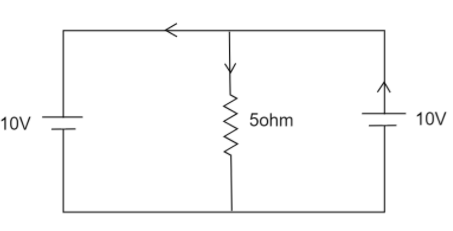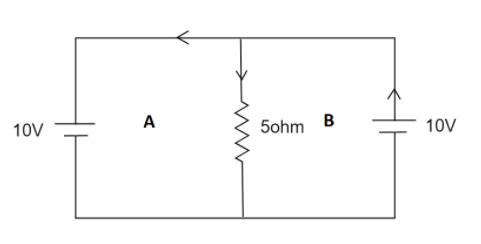
What is current through the $5\Omega $ resistor?

Answer
218.1k+ views
Hint: Here we have a closed-loop of a conductor that we can divide into two elementary loops to simplify the problem. Also, we can use one of Kirchhoff’s laws to figure out our desired answer. Once we learn physics here, then it is a fundamental problem of algebra.
Complete step by step solution:
We take the closed-loop of current and part them into two sections $A$ and $B$ as shown in the figure below-

In both the current-carrying loop, the current is flowing counter-clockwise. So here we use Kirchhoff’s Voltage Law (KVL) to find out the current through the $5\Omega $ resistor.
Kirchhoff’s Second Law or Kirchhoff’s Voltage Law states that the algebraic sum of all the voltages around any closed loop in that circuit equals zero for a series of the closed-loop path.
We assume that the current through the $5\Omega $ resistor is $i$ (ampere).
According to Kirchhoff’s Voltage Law in the loop $A$-
$\Rightarrow 10 - 5i = 0$ ………$(1)$
Since the voltage difference across the resistor $10V$ and $i$ current is flowing through the resistor.
According to Kirchhoff’s Voltage Law in the loop $B$-
$\Rightarrow 10 - 5i = 0$ ………$(2)$
Since here also the voltage difference across the resistor $10V$ and $i$ current is flowing through the resistor.
So from both the above two equations, we can find out the value of $i$-
Hence,
$\Rightarrow 5i = 10$
$ \Rightarrow i = \dfrac{{10}}{5}$
$ \Rightarrow i = 2A$
Therefore, the current through the $5\Omega $ resistor is $2A$.
Note: We can use Kirchhoff’s Second Law, i.e., Kirchhoff’s Current Law, to determine the current at a junction in a closed current-carrying loop. A point of caution, we can only use these laws in a closed loop. These laws are advantageous in complex electric circuits.
Complete step by step solution:
We take the closed-loop of current and part them into two sections $A$ and $B$ as shown in the figure below-

In both the current-carrying loop, the current is flowing counter-clockwise. So here we use Kirchhoff’s Voltage Law (KVL) to find out the current through the $5\Omega $ resistor.
Kirchhoff’s Second Law or Kirchhoff’s Voltage Law states that the algebraic sum of all the voltages around any closed loop in that circuit equals zero for a series of the closed-loop path.
We assume that the current through the $5\Omega $ resistor is $i$ (ampere).
According to Kirchhoff’s Voltage Law in the loop $A$-
$\Rightarrow 10 - 5i = 0$ ………$(1)$
Since the voltage difference across the resistor $10V$ and $i$ current is flowing through the resistor.
According to Kirchhoff’s Voltage Law in the loop $B$-
$\Rightarrow 10 - 5i = 0$ ………$(2)$
Since here also the voltage difference across the resistor $10V$ and $i$ current is flowing through the resistor.
So from both the above two equations, we can find out the value of $i$-
Hence,
$\Rightarrow 5i = 10$
$ \Rightarrow i = \dfrac{{10}}{5}$
$ \Rightarrow i = 2A$
Therefore, the current through the $5\Omega $ resistor is $2A$.
Note: We can use Kirchhoff’s Second Law, i.e., Kirchhoff’s Current Law, to determine the current at a junction in a closed current-carrying loop. A point of caution, we can only use these laws in a closed loop. These laws are advantageous in complex electric circuits.
Recently Updated Pages
Arithmetic, Geometric & Harmonic Progressions Explained

Cartesian Form of Vector Explained: Formula, Examples & Uses

Apparent Frequency Explained: Formula, Uses & Examples

Calorimetry: Definition, Principles & Calculations

Centrifugal Force Explained: Definition, Formula & Examples

Charge in a Magnetic Field: Definition, Formula & Examples

Trending doubts
JEE Main 2026: Application Form Open, Exam Dates, Syllabus, Eligibility & Question Papers

Derivation of Equation of Trajectory Explained for Students

Hybridisation in Chemistry – Concept, Types & Applications

Understanding the Angle of Deviation in a Prism

Understanding Collisions: Types and Examples for Students

Understanding Atomic Structure for Beginners

Other Pages
JEE Advanced Marks vs Ranks 2025: Understanding Category-wise Qualifying Marks and Previous Year Cut-offs

How to Convert a Galvanometer into an Ammeter or Voltmeter

Ideal and Non-Ideal Solutions Explained for Class 12 Chemistry

Degree of Dissociation: Meaning, Formula, Calculation & Uses

Understanding Electromagnetic Waves and Their Importance

Understanding Average and RMS Value in Electrical Circuits




